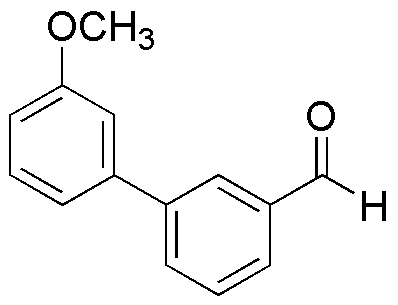3-(3-Methoxyphenyl)benzaldehyde is widely utilized in research focused on:
- Organic Synthesis: This compound serves as a key intermediate in the synthesis of various organic molecules, including pharmaceuticals and agrochemicals, enhancing efficiency in chemical reactions.
- Flavor and Fragrance Industry: It is used to create aromatic compounds in perfumes and flavorings, providing a pleasant scent profile that appeals to consumers.
- Material Science: The compound can be incorporated into polymer formulations, improving the thermal and mechanical properties of materials used in various applications.
- Biological Research: It acts as a building block for developing new compounds with potential therapeutic effects, particularly in cancer research, offering hope for innovative treatments.
- Analytical Chemistry: Utilized as a standard in chromatographic methods, it aids in the identification and quantification of similar compounds in complex mixtures, ensuring accuracy in research results.
General Information
Properties
Safety and Regulations
Applications
3-(3-Methoxyphenyl)benzaldehyde is widely utilized in research focused on:
- Organic Synthesis: This compound serves as a key intermediate in the synthesis of various organic molecules, including pharmaceuticals and agrochemicals, enhancing efficiency in chemical reactions.
- Flavor and Fragrance Industry: It is used to create aromatic compounds in perfumes and flavorings, providing a pleasant scent profile that appeals to consumers.
- Material Science: The compound can be incorporated into polymer formulations, improving the thermal and mechanical properties of materials used in various applications.
- Biological Research: It acts as a building block for developing new compounds with potential therapeutic effects, particularly in cancer research, offering hope for innovative treatments.
- Analytical Chemistry: Utilized as a standard in chromatographic methods, it aids in the identification and quantification of similar compounds in complex mixtures, ensuring accuracy in research results.
Documents
Safety Data Sheets (SDS)
The SDS provides comprehensive safety information on handling, storage, and disposal of the product.
Product Specification (PS)
The PS provides a comprehensive breakdown of the product’s properties, including chemical composition, physical state, purity, and storage requirements. It also details acceptable quality ranges and the product's intended applications.
Certificates of Analysis (COA)
Search for Certificates of Analysis (COA) by entering the products Lot Number. Lot and Batch Numbers can be found on a product’s label following the words ‘Lot’ or ‘Batch’.
Numéro de catalogue
Numéro de lot/série
Certificates Of Origin (COO)
This COO confirms the country where the product was manufactured, and also details the materials and components used in it and whether it is derived from natural, synthetic, or other specific sources. This certificate may be required for customs, trade, and regulatory compliance.
Numéro de catalogue
Numéro de lot/série
Safety Data Sheets (SDS)
The SDS provides comprehensive safety information on handling, storage, and disposal of the product.
DownloadProduct Specification (PS)
The PS provides a comprehensive breakdown of the product’s properties, including chemical composition, physical state, purity, and storage requirements. It also details acceptable quality ranges and the product's intended applications.
DownloadCertificates of Analysis (COA)
Search for Certificates of Analysis (COA) by entering the products Lot Number. Lot and Batch Numbers can be found on a product’s label following the words ‘Lot’ or ‘Batch’.
Numéro de catalogue
Numéro de lot/série
Certificates Of Origin (COO)
This COO confirms the country where the product was manufactured, and also details the materials and components used in it and whether it is derived from natural, synthetic, or other specific sources. This certificate may be required for customs, trade, and regulatory compliance.


